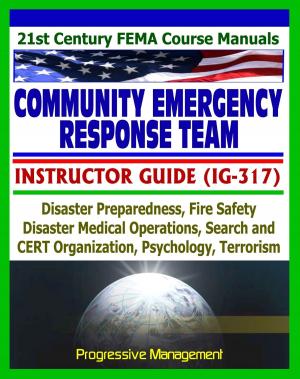A Guide to the Study and Use of Military History: Great Historians, American and World Military History, World War, Museums and Collections, Academic World, Army School System, Art, Field Detachment
Nonfiction, History, Military, United States| Author: | Progressive Management | ISBN: | 9781310271601 |
| Publisher: | Progressive Management | Publication: | March 28, 2015 |
| Imprint: | Smashwords Edition | Language: | English |
| Author: | Progressive Management |
| ISBN: | 9781310271601 |
| Publisher: | Progressive Management |
| Publication: | March 28, 2015 |
| Imprint: | Smashwords Edition |
| Language: | English |
This Guide to the Study and Use of Military History is designed to foster an appreciation of the value of military history and explain its uses and the resources available for its study. It is not a work to be read and lightly tossed aside, but one the career soldier should read again or use as a reference at those times during his career when necessity or leisure turns him to the contemplation of the military past. The Guide consists of four parts. Part One is general in nature and deals with the nature of history as a discipline, military history as a branch of that discipline, the uses of military history, and suggested methods of reading and study. Part Two is a guide to the areas of study and the materials available for study in each. It consists of seven bibliographical essays—one on the great military historians and philosophers with whom all students of military history should have some acquaintance, two on world military history, three specifically on American military history, and a final essay on the merging of American and world military history since the end of World War II. Each of the period essays weaves its bibliographical information into the framework of a discussion of the main military developments of the era covered, introducing, where pertinent, varying historical interpretations of events and issues. Each contains at the end an alphabetical listing of all works mentioned.
Part Three deals with U.S. Army historical programs and activities and how the Army uses or has used military history. This part informs the reader of the resources available within the Army for study and research in military history and some of the practical uses of history in staff work. Part Four similarly deals, albeit more briefly, with military history outside the Army—in other elements of the Department of Defense, in foreign military establishments, and in the academic world. Finally two appendices provide annotated listings of reference works and historical periodicals of greatest interest and utility to the student of military history.
A Guide to the Study and Use of Military History * Chapter 1 - The Nature of History * Chapter 2 - A Perspective on Military History * Chapter 3 - An Approach to the Study of Military History * Section Two: Bibliographical Guide * Chapter 4 - The Great Military Historians and Philosophers * Chapter 5 - Military History to the End of the Eighteenth Century * Chapter 6 - World Military History, 1786-1945 * Chapter 7 - American Military History: The Early Period, 1607-1815 * Chapter 8 - American Military History: The Middle Years, 1815-1916 * Chapter 9 - The United States and the Two World Wars * Chapter 10 - The United States and the World Military Scene Since 1945 * Section Three: Army Programs, Activities, and Uses * Chapter 11 - A Century of Army Historical Work * Chapter 12 - The U.S. Army Military History Institute * Chapter 13 - The Military History Detachment in the Field * Chapter 14 - The Army Art Program * Chapter 15 - Military Museums and Collections * Chapter 16 - The Place of Unit History * Chapter 17 - Military History in the Army School System * Chapter 18 - The Use of Military History in Staff Work * Chapter 19 - Military History and Army Records * Chapter 20 - Writing for Official and Unofficial Publication * Section Four: History Outside the U.S. Army * Chapter 21 - Military History in the Department of Defense * Chapter 22 - Official Programs Abroad * Chapter 23 - Military History and the Academic World
This Guide to the Study and Use of Military History is designed to foster an appreciation of the value of military history and explain its uses and the resources available for its study. It is not a work to be read and lightly tossed aside, but one the career soldier should read again or use as a reference at those times during his career when necessity or leisure turns him to the contemplation of the military past. The Guide consists of four parts. Part One is general in nature and deals with the nature of history as a discipline, military history as a branch of that discipline, the uses of military history, and suggested methods of reading and study. Part Two is a guide to the areas of study and the materials available for study in each. It consists of seven bibliographical essays—one on the great military historians and philosophers with whom all students of military history should have some acquaintance, two on world military history, three specifically on American military history, and a final essay on the merging of American and world military history since the end of World War II. Each of the period essays weaves its bibliographical information into the framework of a discussion of the main military developments of the era covered, introducing, where pertinent, varying historical interpretations of events and issues. Each contains at the end an alphabetical listing of all works mentioned.
Part Three deals with U.S. Army historical programs and activities and how the Army uses or has used military history. This part informs the reader of the resources available within the Army for study and research in military history and some of the practical uses of history in staff work. Part Four similarly deals, albeit more briefly, with military history outside the Army—in other elements of the Department of Defense, in foreign military establishments, and in the academic world. Finally two appendices provide annotated listings of reference works and historical periodicals of greatest interest and utility to the student of military history.
A Guide to the Study and Use of Military History * Chapter 1 - The Nature of History * Chapter 2 - A Perspective on Military History * Chapter 3 - An Approach to the Study of Military History * Section Two: Bibliographical Guide * Chapter 4 - The Great Military Historians and Philosophers * Chapter 5 - Military History to the End of the Eighteenth Century * Chapter 6 - World Military History, 1786-1945 * Chapter 7 - American Military History: The Early Period, 1607-1815 * Chapter 8 - American Military History: The Middle Years, 1815-1916 * Chapter 9 - The United States and the Two World Wars * Chapter 10 - The United States and the World Military Scene Since 1945 * Section Three: Army Programs, Activities, and Uses * Chapter 11 - A Century of Army Historical Work * Chapter 12 - The U.S. Army Military History Institute * Chapter 13 - The Military History Detachment in the Field * Chapter 14 - The Army Art Program * Chapter 15 - Military Museums and Collections * Chapter 16 - The Place of Unit History * Chapter 17 - Military History in the Army School System * Chapter 18 - The Use of Military History in Staff Work * Chapter 19 - Military History and Army Records * Chapter 20 - Writing for Official and Unofficial Publication * Section Four: History Outside the U.S. Army * Chapter 21 - Military History in the Department of Defense * Chapter 22 - Official Programs Abroad * Chapter 23 - Military History and the Academic World















